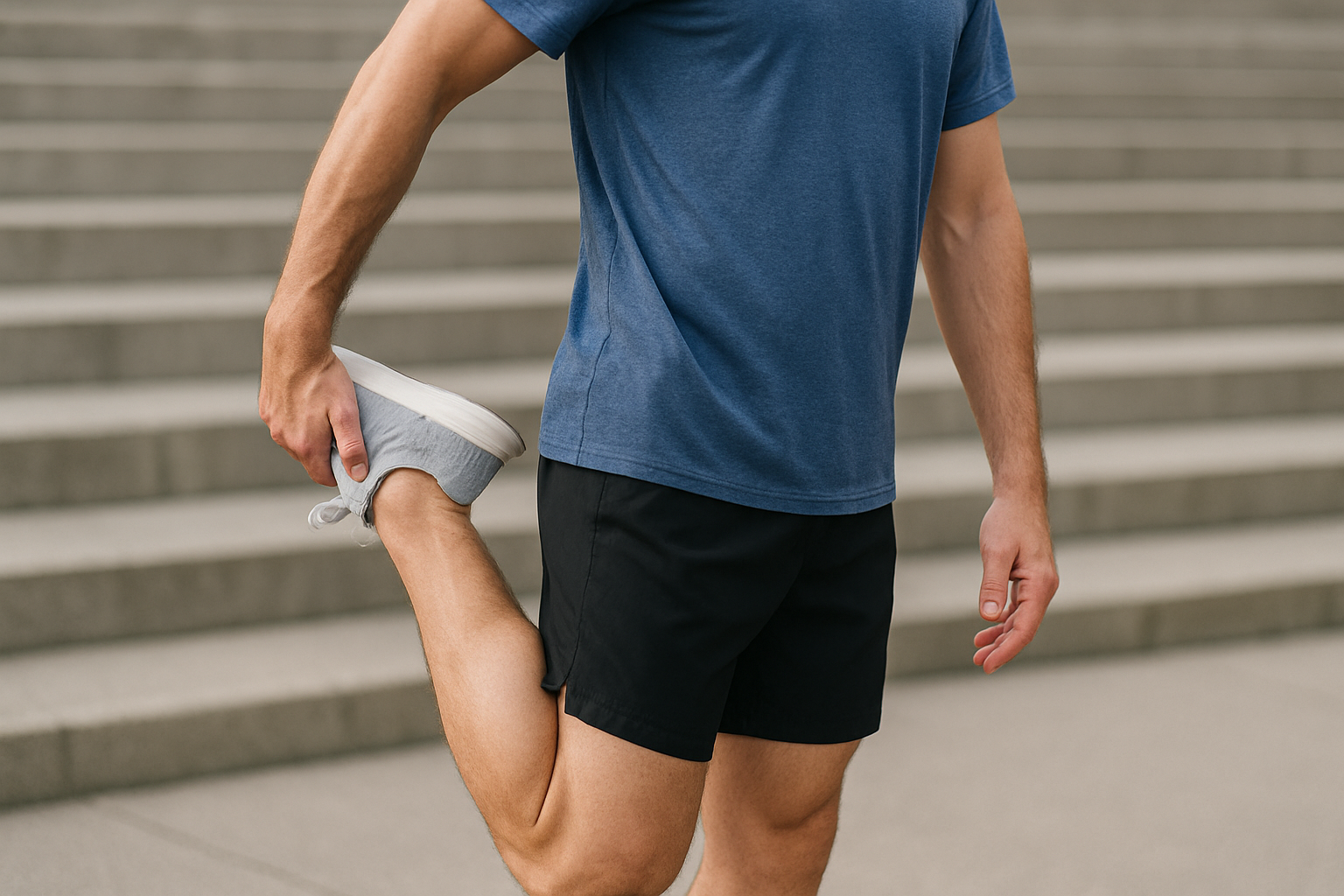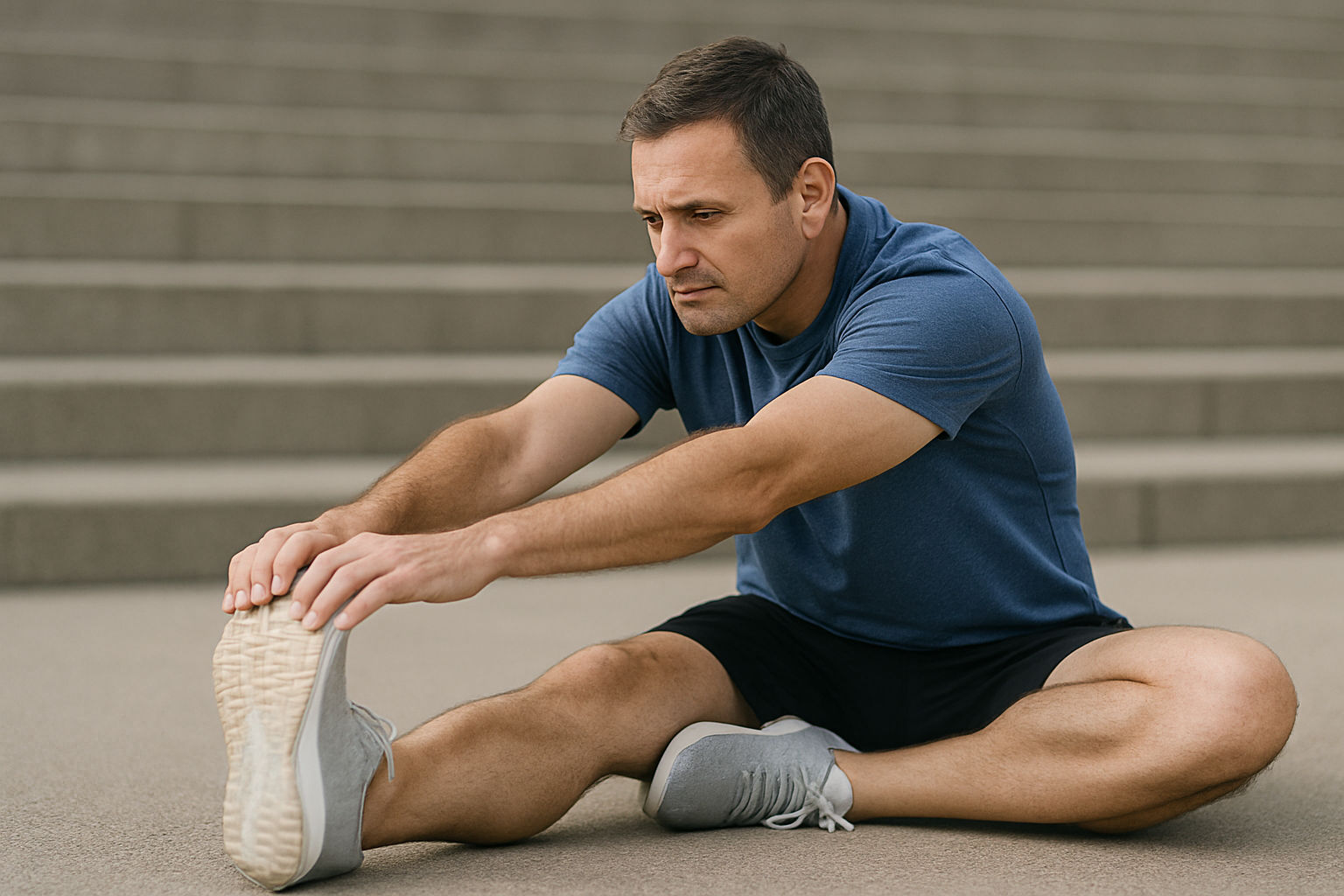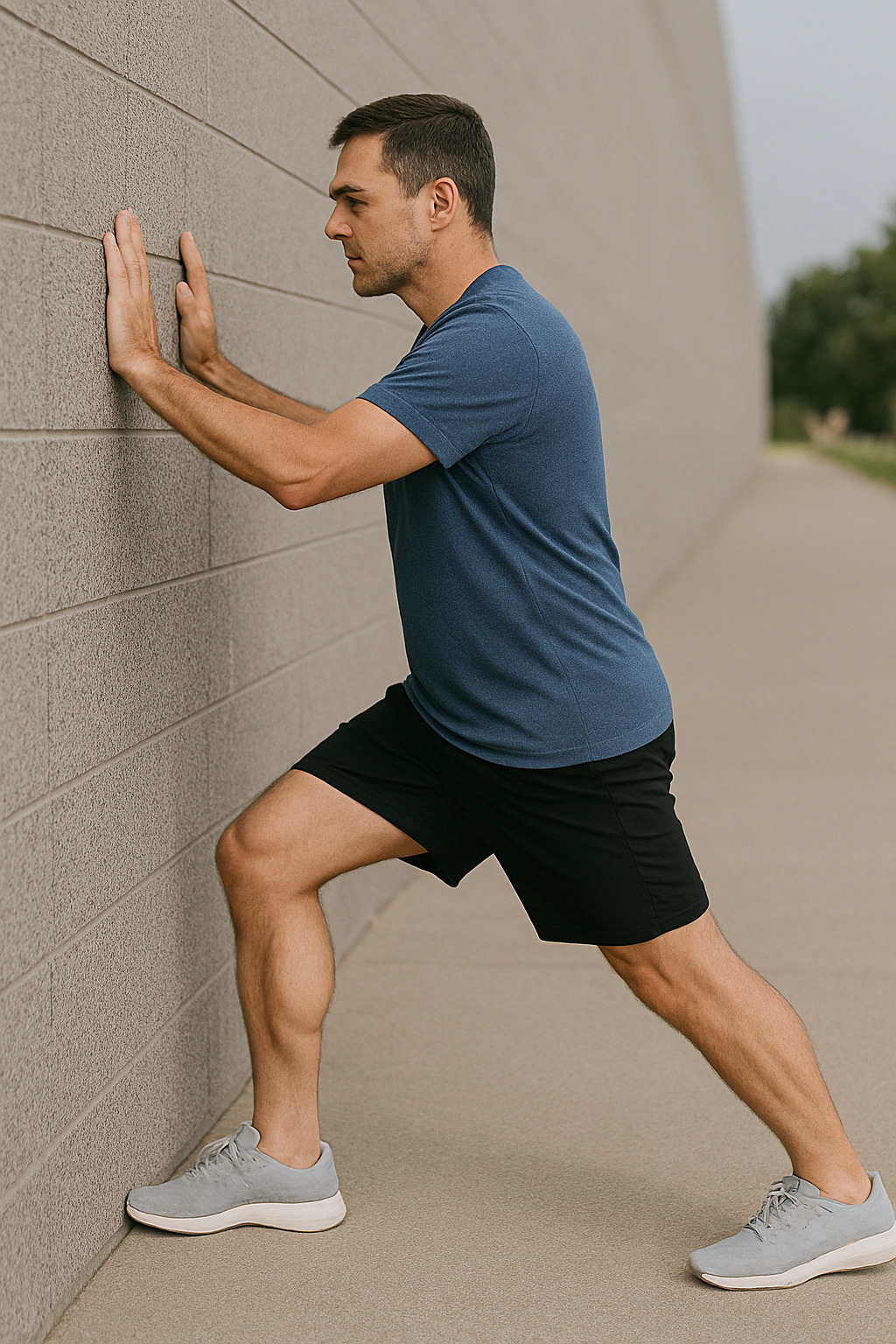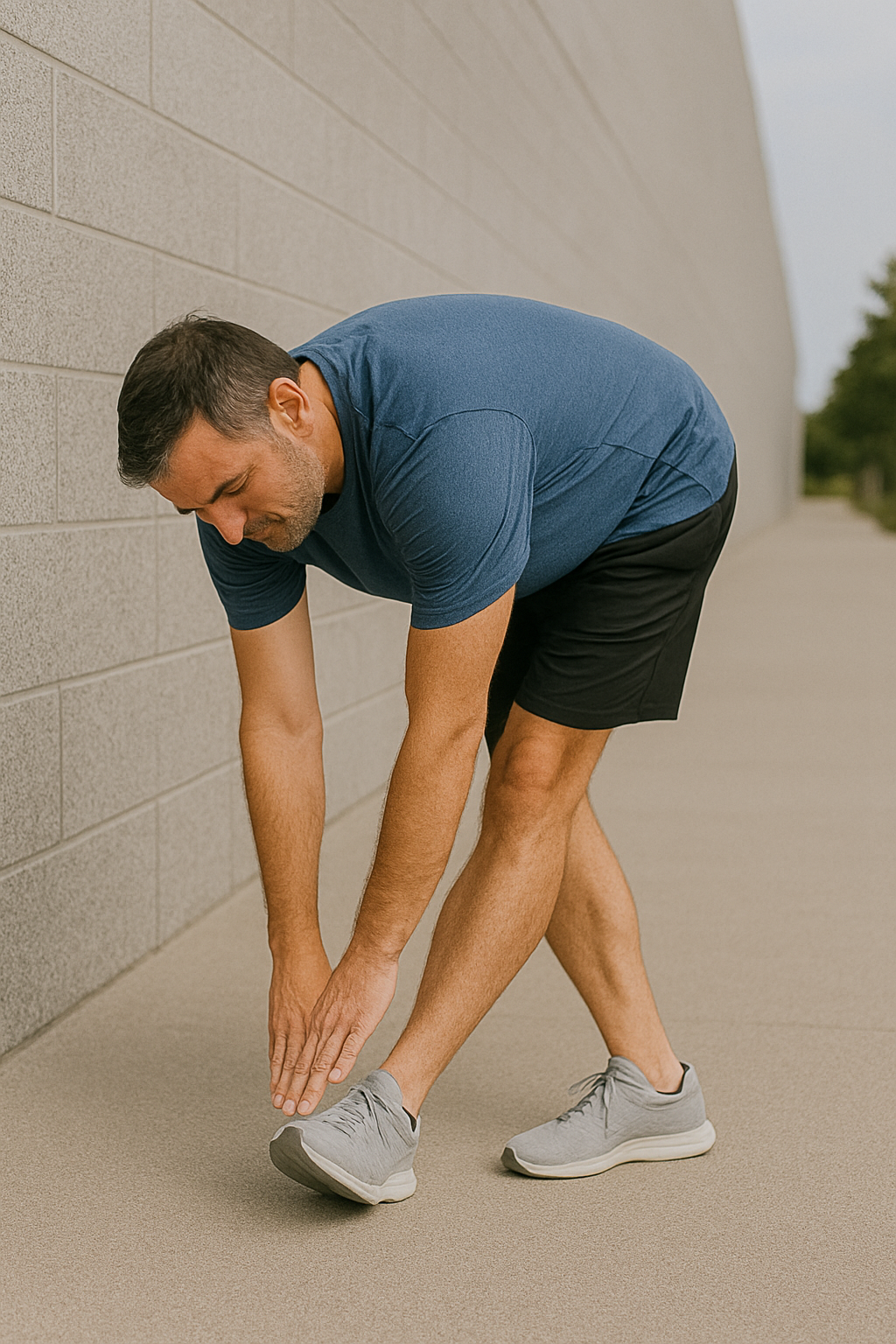Stretches for Knee Pain

Essential Stretches to Alleviate Knee Pain
Stretching can be a simple yet powerful way to relieve knee pain, improve mobility, and support joint health. Whether you’re dealing with arthritis, overuse, or general stiffness, daily stretching can help loosen tight muscles around the knee and reduce tension on the joint.
Here are some of the best stretches to help ease knee pain:
Quadriceps Stretch: Stand tall, grab your ankle behind you, and gently pull your heel toward your glutes. This stretch targets the front of the thigh, helping to reduce pressure on the knee.

Hamstring Stretch: Sit on the floor with one leg extended and the other bent. Reach toward your toes on the extended leg to stretch the back of the thigh and relieve stress behind the knee.

Calf Stretch: Face a wall, step one foot back, and press the heel into the floor. This improves ankle flexibility and reduces tension in the lower leg that can impact knee alignment.

IT Band Stretch: Cross one leg behind the other and then touch the ground or as far as you can. This stretch targets the outer thigh and can help relieve lateral knee pain.

Incorporating these stretches into your daily routine can:
- Improve flexibility and range of motion
- Increase blood flow to support healing
- Reduce stiffness and inflammation in the knee area
Hold each stretch for 15 to 30 seconds and repeat 2 to 3 times on each side. Avoid bouncing, and stretch only to the point of gentle tension, not pain.
For best results, pair stretching with strengthening exercises such as leg lifts, wall sits, or step-ups to build support around the knee. Stronger muscles help stabilize the joint and prevent further discomfort. Always check with a healthcare provider or physical therapist before beginning any new routine, especially if you have existing knee conditions or injuries.
Additional Stretches to Help Relieve Knee Pain
- Hip Flexor Stretch:
Tight hip flexors can affect knee alignment.
How to do it: Kneel on one knee with the other foot in front at a 90-degree angle. Gently push your hips forward until you feel a stretch in the front of your hip. Hold for 20–30 seconds. - Adductor (Inner Thigh) Stretch:
Tight inner thigh muscles can pull on the knee joint.
How to do it: Sit with your feet together and knees bent outward (butterfly position). Gently press your knees toward the floor using your elbows. - Glute Stretch (Figure 4 Stretch):
Tight glutes can limit hip mobility and stress the knees.
How to do it: Lie on your back, cross one ankle over the opposite thigh, and pull the uncrossed leg toward your chest. - Standing Hamstring Stretch (Modified):
A good alternative for those with limited floor mobility.
How to do it: Place one heel on a low surface (like a step or bench), keep your leg straight, and gently hinge forward at the hips while keeping your back flat. - Standing IT Band Stretch (Wall-Assisted):
Helps if you struggle with lateral knee pain.
How to do it: Stand sideways next to a wall, cross the leg farthest from the wall behind the other, and lean your upper body toward the wall.
The Importance of Stretching for Knee Health
Stretching plays a vital role in maintaining knee health. Regularly stretching the muscles surrounding the knee joint can increase flexibility, promote blood flow, and reduce stiffness. This helps improve the range of motion, making everyday activities easier.
Stretching can help ease tension in the muscles and joints, alleviating discomfort. When muscles are flexible, they can better absorb stress, minimizing the risk of injuries or exacerbating existing conditions such as arthritis. Incorporating stretching into a daily routine can significantly enhance overall knee function.
In addition to the physical benefits, stretching can also have a positive impact on mental well-being. A stretching regimen allows individuals to connect with their physical state, encouraging mindfulness and body awareness. This practice can be particularly beneficial for those recovering from knee injuries, as it fosters a sense of control and empowerment over one’s rehabilitation process. Stretching can also serve as a form of stress relief, helping to alleviate tension not just in the knees, but throughout the entire body.
It is also worth noting that different types of stretching can yield various benefits. Static stretching, where a muscle is extended and held in a position, is excellent for improving flexibility and lengthening muscle fibers. On the other hand, dynamic stretching, which involves controlled movements that gently take you to the limits of your range of motion, can be particularly effective as a warm-up before physical activities. By understanding and utilizing these different stretching techniques, individuals can tailor their routines to better support knee health and overall physical performance.
How to Properly Perform Knee Stretches
Proper technique is important to gain maximum benefit from knee stretches while avoiding injury. Always warm up before you begin stretching. Warming up can include a few minutes of walking or gentle movements to prepare your muscles.
Aim to hold each position for 15 to 30 seconds when performing stretches. Breathe deeply and avoid bouncing, which can strain muscles. Instead, gently ease into each stretch, allowing your body to relax.
It is also essential to listen to your body. If a stretch causes pain, stop immediately. Modifications can be made. It is vital to prioritize safety over intensity. Gradually increasing the difficulty of stretches is a good approach as flexibility improves.
Incorporating Strengthening Exercises with Stretching
Adding strengthening exercises can further enhance knee support and reduce pain. Strengthening the muscles around the knee stabilizes the joint, which can alleviate some of the pressure caused by conditions like arthritis.
Consider incorporating exercises such as leg raises, wall sits, and partial squats into your routine. These exercises help build strength in the quadriceps, hamstrings, and calves—all crucial for knee stability.
For best results, combine these strengthening exercises with your stretching routine. This balanced approach can improve overall knee function and comfort.
How Stretching Can Help Knee Arthritis
Stretching can be particularly beneficial for individuals experiencing knee arthritis. The gentle movements can promote lubrication in the joint, thus reducing stiffness and pain. Enhanced flexibility can lead to improved mobility, making daily tasks less daunting.
Consistent stretching can help manage inflammation associated with arthritis. It may also prevent the development of muscle imbalances that can result from altered movement patterns due to pain.
As a part of a comprehensive arthritis management approach, stretching can significantly improve the quality of life. It allows individuals to maintain activity levels and independence while managing their symptoms.
Tips for Preventing Knee Pain Through Flexibility
To prevent knee pain, developing and maintaining flexibility is essential. Here are some tips to incorporate into your routine:
- Be Consistent: Consistency is key to improving flexibility. Aim to stretch at least three times a week to see results.
- Warm-Up Daily: Incorporate warm-up exercises as part of your daily routine, especially before engaging in physical activity.
- Listen to Your Body: Pay attention to how you feel during stretching. Never push past your comfort zone.
- Use Proper Footwear: Invest in supportive shoes if you are active. Good footwear can make a significant difference in your knee health.
- Stay Hydrated: Keeping your body hydrated supports joint health and overall bodily functions.
By following these tips and incorporating stretching into your daily life, you can work towards preventing knee pain and enhancing your mobility.
If you are seeking advanced knee pain relief without surgery, opioids, or downtime, Arthritis Knee Pain Centers is here for you. With over 60,000+ patients who have experienced relief from osteoarthritis knee pain, our specially trained physicians utilize advanced digital imaging and FDA-approved viscosupplementation gel injections to increase mobility, reduce pain, delay surgery, and decrease the need for pain medications.
Take the first step towards improving your knee health and Schedule Your No Charge Screening today to see how our treatments can help you.
